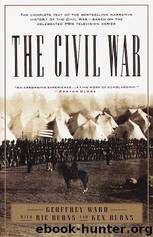The Civil War by Geoffrey C. Ward; Ken Burns; Ric Burns

Author:Geoffrey C. Ward; Ken Burns; Ric Burns
Language: eng
Format: mobi
Tags: United States, Military, History, Civil War Period (1850-1877), General
ISBN: 9780679755432
Publisher: Random House, Inc.
Published: 1994-01-15T05:00:00+00:00
Richmond. February 11th. Some idea may be formed of the scarcity of food in this city from the fact that, while my youngest daughter was in the kitchen today a young rat came out of its hole and seemed to beg for something to eat; she held out some bread which it ate from her hand and seemed grateful. Several others soon appeared and were as tame as kittens. Perhaps we shall have to eat them!
Richmond fishmongers hiked their prices, and hired thugs to ensure they were not undersold. Merchants filled warehouses with barrels of flour, then held them for the highest possible price. On the eve of one major battle, speculators bought up all the coffins and mourning crepe in town, then jacked up the prices. “Had these contemptible wretches the power,” said the Richmond Examiner, “they would bottle the universal air and sell it at so much a bottle.”
Some—including many of the region’s wealthiest planters—also traded more or less openly with the North, bribing troops on both sides of the line to look the other way while bales of cotton moved north, and gold and Federal currency made their way south. When the wife of one Mississippi planter objected, he told her, “I wish to fill my pockets. I can in five years make a larger fortune than ever.”
Nothing embittered soldiers at the front more than the knowledge that comfortable civilians were further enriching themselves at their expense. “The fact is,” an officer wrote home, “that … Yankee gold is fast accomplishing what Yankee arms could never achieve—the subjugation of our people.”
The average family food bill rose from $6.65 per month before Fort Sumter to $68 dollars by mid-1863, and a single cake of soap cost $1.10—a tenth of a soldier’s monthly pay Northern greenbacks were worth four times as much as Confederate bills throughout the South, and northern gold pieces were especially sought after—even in economic terms, it was hard for the South to remain truly independent.
Prices continued to rise 10 percent a month. “You take your money to the market in the market basket,” wrote a South Carolina judge, “and bring home what you buy in your pocketbook.” By autumn, a barrel of flour at Richmond would cost $70. By year’s end it would cost $250, a pair of shoes between $200 and $800, and an officer’s uniform $2,000.
A soldier wrote home that with soaring liquor prices “it would cost about fifty dollars [just] to get tight here.” Beggars who had once asked for a nickel now demanded a dollar.
While the northern blockade remained in place, the low, sleek, gray-painted Confederate blockade runners—the Banshee, Let Her Be, Let Her Rip, Leopard, Lynx, Stonewall Jackson, Jeff Davis, Lady Davis—continued to slip through the Union cordon, carrying cotton to Bermuda or Nassau and bringing back precious manufactured goods, luxury items—and some 600,000 rifles.
Fifteen hundred blockade runners were seized, sunk, or burned by Federal ships during the war, but hundreds more made it through; one vessel, the Hattie, did so sixty times.
Download
This site does not store any files on its server. We only index and link to content provided by other sites. Please contact the content providers to delete copyright contents if any and email us, we'll remove relevant links or contents immediately.
| African Americans | Civil War |
| Colonial Period | Immigrants |
| Revolution & Founding | State & Local |
Cat's cradle by Kurt Vonnegut(13855)
Pimp by Iceberg Slim(12922)
Underground: A Human History of the Worlds Beneath Our Feet by Will Hunt(11250)
4 3 2 1: A Novel by Paul Auster(11032)
The Radium Girls by Kate Moore(10901)
American History Stories, Volume III (Yesterday's Classics) by Pratt Mara L(4821)
Perfect Rhythm by Jae(4616)
Wiseguy by Nicholas Pileggi(4581)
The Fire Next Time by James Baldwin(4336)
Paper Towns by Green John(4163)
A Higher Loyalty: Truth, Lies, and Leadership by James Comey(4024)
Pale Blue Dot by Carl Sagan(3995)
The Mayflower and the Pilgrims' New World by Nathaniel Philbrick(3905)
The Doomsday Machine by Daniel Ellsberg(3725)
Too Much and Not the Mood by Durga Chew-Bose(3689)
Killers of the Flower Moon: The Osage Murders and the Birth of the FBI by David Grann(3604)
The Borden Murders by Sarah Miller(3581)
The Sympathizer by Viet Thanh Nguyen(3460)
Sticky Fingers by Joe Hagan(3449)
